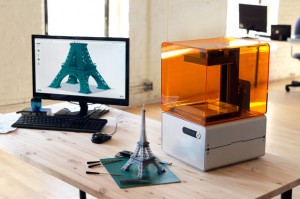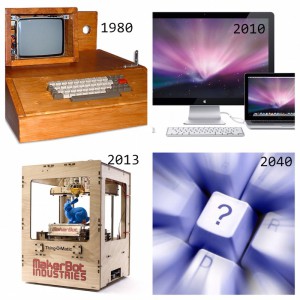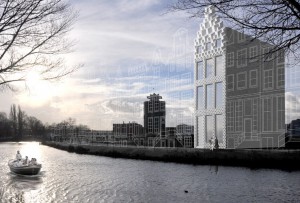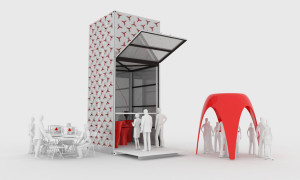 We can hear and read more and more about 3D printing and about all the possibilities this offers. Unfortunately also about the negative sides, like printing guns… In this blog I will mainly look into the possible influences of this technique according to cities.
We can hear and read more and more about 3D printing and about all the possibilities this offers. Unfortunately also about the negative sides, like printing guns… In this blog I will mainly look into the possible influences of this technique according to cities.
In 30 years?
At the moment 3D printing is at an early stage of existence but it is assumed to change rapidly. For instance have a look at the incredible quick development of the PC. The picture below shows the Apple1, which appeared around 1977. Now, 35 years later, it has evolved not only into the iMac. At the same time to devices like smartphones and since three years (!) the increase of tablets. When we have a look at the current shape of the 3D printers they resemble the shape of the former Apple 1… Just imagine what 3D printers might look like in 30 years!
Not only the shape of computers has changed completely, but at the same time the software, the storage capacity, the use etcetera. We can expect the same development in 3D printing. Not only better software but probably also printing with other materials.
 At the moment it is mainly plastic, while it is going to be possible with a lot more materials. Experiments on printing biological tissue are worked on currently. Who knows we will be able to print a replaceable skin for severe skin burns or even new limbs or organs.
At the moment it is mainly plastic, while it is going to be possible with a lot more materials. Experiments on printing biological tissue are worked on currently. Who knows we will be able to print a replaceable skin for severe skin burns or even new limbs or organs.
The costs of a 3d-printer are lowering drastically: by using open source technology the costs of a 3D-print are around 2.000 euros per print. In the “Bijenkorf” a 3D-printer was for sale for 1.300 euros. This is a very reasonable price for many companies and households. At this moment practical applications are limited.
Raw materials in town
We are talking about a development with huge consequences! I think 3D printing is going to revolutionize life in cities. Especially when you look at this from the angle of durability. Recycling will get a new impuls: litter will become raw material. Throw different old materials in a shredder and print new items. In need of a new interior? Something got broken? Just print new things. Clutter is going to get a complete new (economical) meaning.
Next to this the goods/raw material stream will change completely: distribution and transhipment, production environment etc., will be filled in in a different way. Raw materials meant for production will be based more on a recycling base. Less raw materials and waste will be transported in and out of the city. The complete chain “supply – products – waste” is going to be uprooted by this. As a result complete new business models and chances for new services and products.
Printing 3D buildings
This will increase one stroke further. Next to ‘normal’ daily goods there are lots of other possibilities. In Amsterdam, DUS Architects started to print a Canal House in the Northern District. They try this with various partners to explore all possibilities. Last year, they developed a huge 3D printer that is capable of printing elements of 2,5 x 2 x 2 meter. A great starting point for parts of a concrete building, varying from wall parts to window parts.
They have the intention to experiment with other kind of materials within the project, next to the, at the moment, usual plastic. Think of wood for instance, a kind of MDF, which not only feels more natural than plastic but is probably better for the living environment inside the canal house. It might be possible to create glass, stone (bricks, cement, concrete) and even metal.
Next to the realisation of a real canal house is to learn from it the secondary goal of this project. What does work and what does not. And how can this new technology contribute to an increase of the durability, safety and climate control of these buildings. These insights are essential if the technology is going to be implied in cities on a large scale.
Long-term influence on cities
I can see huge developments in the city circuit: 3D printing will change the complete circuit of raw materials, goods, public space and buildings drastically. It should be good if (municipal) waste companies indent this. This could be a new model to get a grip on the expenses of management and development of real estate and public space, or even drastically reduce. Especially now raw materials get more expensive on the international market.
The chain of sale, production and production is going to change completely: you will have a look at a product in a shop and buy the print file, optionally with semi-finished products. This will start new shops, which are able to put this together, specified on the customer’s whish, so there won’t be any over-production. It only requires the right raw materials, so they should be available.
Next to this the transport of raw materials will change completely with huge consequences for distribution and transhipment areas. I expect major consequences for the urban ports but especially for the port of Rotterdam.
Short-term significance
I can see entrepreneurs hooking up on this. There will appear new ways of earning for the product chains (raw material to waste, cradle-to-cradle). New shops will turn up which offer the 3D printing (these will disappear again on the long term, like the copy shops and video stores). What will remain is going to be the trade in specific software, the sales of raw materials and shredders, and print files.
Is 3D printing possibly the new industrial revolution? I think it is!



Leave a reply